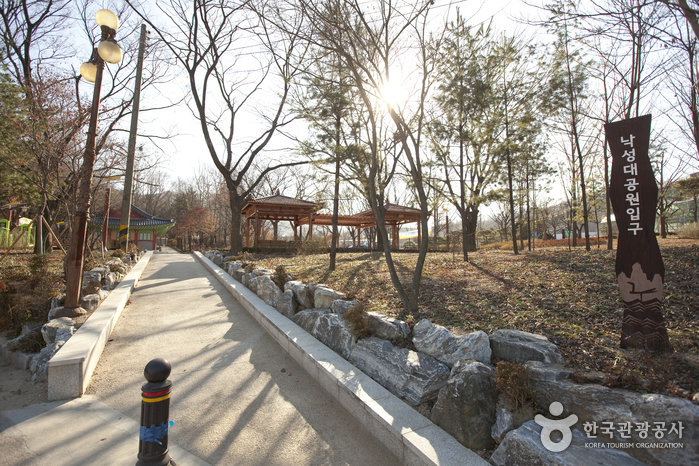Olive Young - Naebang Station Branch [Tax Refund Shop] (올리브영 내방역)
1.6Km 2024-04-22
184, Bangbae-ro, Seocho-gu, Seoul
-
Atelier Plastic Surgery [Tax Refund Shop] (아틀리에성형외과의원)
2.0Km 2024-06-27
89, Donggwang-ro, Seocho-gu, Seoul
-
National Gugak Museum (국립국악박물관)
2.0Km 2021-08-13
2364, Nambusunhwan-ro, Seocho-gu, Seoul
+82-2-580-3130
The National Gugak Museum opened on February 23, 1995 as the first gugak museum in Korea, featuring approximately 6,000 pieces of gugak-related materials and relics which have both historical and cultural value. It is comprised of seven themed permanent exhibition halls that present 250 pieces of audio and video clips regarding gugak. In the 3D room, visitors can enjoy 3D animation at all times. The museum also hosts special exhibitions in unique and interesting themes.
National Gugak Center (국립국악원)
2.0Km 2025-01-17
2364 Nambusunhwan-ro, Seocho-gu, Seoul
The National Gugak Center is the governing body established to preserve and promote traditional Korean performing arts. The center can accommodate every type of traditional performing arts, such as palace music, court music, and all other genres including major productions of changgeuk (Korean musical drama). Originally opened in Busan in 1951, the center moved to its current location in Seoul in 1987. The center also opened branch locations in Namwon, Jindo, and Busan in 1992, 2004, and 2008 respectively.
Seoul Arts Center (예술의전당)
2.2Km 2025-01-17
2406 Nambusunhwan-ro, Seocho-gu, Seoul
The Seoul Arts Center is the representative art complex of Korea. It is comprised of the Opera House, Concert Hall, Art Gallery, Calligraphy Museum, Art Material Hall, and an outdoor stage. You can enjoy various performances and exhibitions all in one site.
The Opera House and Concert Hall consist of a total of five performance halls offering an average of 800 performances ever year, whereas the Art Gallery and Calligraphy Museum has seven exhibition halls providing various exhibitions throughout the year. The outdoor stage also provides various genres of performances all year round.
Lotte Mart - Seocho Branch [Tax Refund Shop] (롯데마트 서초점)
2.3Km 2024-04-22
12, Seocho-daero 38-gil, Seocho-gu, Seoul
-
Gwanaksan Mountain Nakseongdae Park (관악산 낙성대공원)
2.4Km 2021-07-16
77, Nakseongdae-ro, Gwanak-gu, Seoul
+82-2-879-6525
Nakseongdae Park was built as a tribute to General Kang Gam-chan (948-1031) of the Goryeo dynasty. In 1973, the city of Seoul reorganized the birthplace of General Kang, resulting in changes to the park. Located inside the park are Anguksa Shrine, the general’s birthplace, and a three-story stone pagoda, which was made during the Goryeo dynasty. The 4.48-meter-high pagoda is made of granite, and is called “Kang Gam-chan Tap (pagoda)” or “Kang Gam-chan Nakseongdae Tap”.
*Anguksa Shrine
Anguksa is a shrine built in 1974 emulating the wooden architecture style of the Goryeo era. The shrine has high ceilings and houses the portrait of General Kang Gam-chan. The shrine is located on the road leading to the back gate of Seoul National University and has become a popular place in the area.
*Nakseongdae Yuji
Nakseongdae Yuji is the birthplace of General Kang Gam-chan and the original location of the three-story pagoda. During the maintenance of Nakseongdae area in 1973, the pagoda was moved into the vicinity of Anguksa Shrine, and a two-meter tall monument was erected in its original location to mark the historical significance of the site.
Bongsanok (봉산옥)
2.4Km 2024-03-25
5-6 Banpo-daero 8-gil, Seocho-gu, Seoul
+82-2-525-2282
Bongsanok, located near the Seoul Arts Center, specializes in manduguk (mandu soup), known for its signature spicy twist with a generous sprinkling of chili pepper powder. The restaurant’s celebrated manduguk features Hwanghae-do-style mandu, stuffed with a savory blend of minced meat, kimchi cabbage, bean sprouts, and chives, all served in a rich beef brisket broth that has been meticulously boiled for twelve hours.
Hangaram Art Museum in Seoul Arts Center (예술의전당 한가람미술관)
2.4Km 2022-12-16
2406, Nambusunhwan-ro, Seocho-gu, Seoul
+82-2-580-1300
Hangaram Art Museum, located in the left wing of the Seoul Arts Center, displays a unique exhibition of formative arts. Established in 1990, the museum has a total area of 15,540 ㎡ and contains 6 exhibition halls (including one for oversized artwork), a storage area, and an art shop. The building features a lighting system that controls the humidity and temperature and is equipped with a luminous ceiling system that captures natural sunlight and feeds it into the museum, allowing visitors to enjoy a brightly lit viewing area.
The Art Square in front of the museum houses a wide range of exclusive artwork and serves as a venue for various events such as the Cloz Art Market. Visitors may also enjoy the open-air café right in front of the building or dine at “Yehyang,” a traditional Korean restaurant right down the stairs.
![Olive Young - Naebang Station Branch [Tax Refund Shop] (올리브영 내방역)](http://tong.visitkorea.or.kr/cms/resource/83/2889483_image2_1.jpg)
![Atelier Plastic Surgery [Tax Refund Shop] (아틀리에성형외과의원)](http://tong.visitkorea.or.kr/cms/resource/95/3314395_image2_1.jpg)

![Lotte Mart - Seocho Branch [Tax Refund Shop] (롯데마트 서초점)](http://tong.visitkorea.or.kr/cms/resource/56/2887956_image2_1.jpg)

 English
English
 한국어
한국어 日本語
日本語 中文(简体)
中文(简体) Deutsch
Deutsch Français
Français Español
Español Русский
Русский